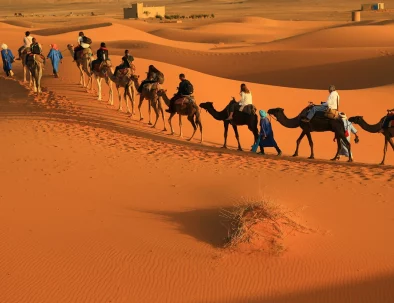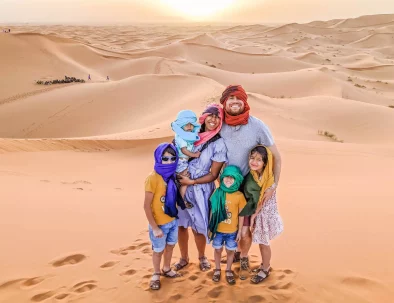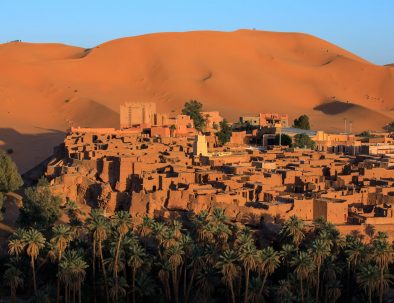Day 1: Arrive in Tangier & Explore
Welcome to Tangier, the gateway between Europe and Africa, a vibrant and historical city. Tangier offers a distinctive fusion of cultures as it stretches along the Maghreb coast at the western entrance to the Strait of Gibraltar. The city has been shaped by numerous factors, drawing artists, spies, and eccentric foreigners. Although it wasn’t always a tourist hotspot, Tangier has changed. The city now attracts tourists worldwide to its newly renovated old quarter and waterfront (an excellent place for a quick stroll).
Explore the maze-like network of commercial and residential alleyways in the Medina (old town), starting there. Explore Petit Socco Square, renowned for its lively markets, boutiques, and cafés. This is an excellent location for eating or people-watching. Visit the cannons at Faro Square for a breathtaking view of the city and take in the sights of the Medina harbor and the Bay of Tangier. Small and condensed enough for a self-guided walk, the Portuguese Tangier Kasbah from the 15th century is a fortified castle. Enter Place du Mechouar after passing through the historic Bab Haha (a gate with views of the sea). You can pay a guide to take you on a tour if you’d like.
Last, stroll to the Place de France along the shopping district of Rue de la Liberté. The Grand Café de Paris and the Hotel El Minzah are located in this bustling plaza, which serves as the heart of contemporary Tangier. In the past, people like Tennessee Williams, Jack Kerouac, Muhammad Asad, Truman Capote, and William S. Burroughs could be found here.
Join the locals for a paseo (stroll) in the late afternoon along Corniche de Tanger, the palm-lined seafront boulevard. Visit Cap Spartel and the Cave of Hercules if you prefer to explore outside the city. Allow at least an hour to allow for transfers and sightseeing. Interestingly, The shape of the cave is thought to resemble that of the African continent when viewed against the Atlantic horizon.
Day 2: Tangier to Chefchaouen
Take a leisurely, private transfer of about 2.5 hours from Tangier to your lodging in Chefchaouen. Take in the scenery as the rolling Rif Mountains replace the flat plains and springtime green hills. Head out to discover Chefchaouen, or simply “chaoeun,” as the locals do after settling into your lodging. Enjoy the laid-back ambiance as you wind through the city’s Medina and its winding labyrinth of picturesque streets.
Chefchaouen, a hip, blue-washed mountain village that feels like its own world, is one of the prettiest towns in Morocco. It is beautifully perched beneath the untamed peaks of the Rif. It was established in 1471 as a stronghold in the struggle against the Portuguese by Idrissid shortfall, descended from the Prophet Mohammed. However, the town grew after Muslim and Jewish Granada refugees arrived in 1494 and began constructing whitewashed homes with tiny balconies, tiled roofs, and patios (often with a citrus tree in the center). The town’s distinctive Spanish flavor is a result of its history.
With its bright blue buildings, red-tiled roofs, and winding lanes that converge on the bustling Plaza Uta el-Hammam and its restored kasbah, the old Medina is a delight of Moroccan and Andalucian influences. Visit the Grand Mosque and Kasbah or browse the nearby souks (markets). Non-Muslims are not permitted inside the mosque, but they are welcome to explore the kasbah’s gardens, museums, and former jail cells and to admire the building’s design.
Walk past the city’s defenses and through its storied gates in the direction of the Hotel Atlas for a spectacular view of the city. If you still have time, climb the path for another 30 minutes to the Spanish Mosque to watch the sunset.
Day 3: Chefchaouen to Fes via Volubilis & Meknes
Take a leisurely, private transfer of about four and a half hours from Chefchaouen to your lodging in Fes. Your driver will make stops along the way at the Roman ruins at Volubilis and the imperial city of Meknes. Make the most of your morning by taking one last stroll through Chefchaouen’s peaceful streets to take in the “Blue City.”
Your first stop is Volubilis, a UNESCO World Heritage Site housing Morocco’s best-preserved Roman ruins, after bidding farewell to the picturesque Rif Mountains. Explore the vast complex’s temples, large merchant homes with visible heating systems, and numerous bright mosaics. The Romans ruled this town for about 200 years before leaving in 285 CE, making it one of the furthest reaches of the Roman Empire.
Continue to Meknes, Moulay Ismail’s imperial capital. Meknes transformed from a modest village to a magnificent capital during Moulay Ismail’s rule (1672–1727 CE). Enjoy taking a stroll through the compact Medina, which has a calmer atmosphere than other cities and is less crowded. In addition to the sporadic souks (markets), you can see Marinid-era architecture at the impressive 19th-century palace of Dar Jama and the 14th-century Medersa Bou Inania. Explore the gardens, castles, Bab al-Mansour, the Mausoleum of Moulay Ismail, and the Royal Stables in the Ville Impériale neighborhood.
Fes will be your last stop. Drive up to the Marinid Tombs to get a beautiful view of the old city before you settle into your lodging. You may see leather drying in the sun on the hillside below.Following the demonstration, the tour will take you into Fes’s Medina, where you can explore the historic streets and neighborhoods, stop by the various artisan neighborhoods (including the tanneries), and view significant historical landmarks like Idriss II’s Tomb and the Al-Qarawaiyin University, the world’s oldest continuously operating university. After your tour, you’ll have the remainder of the afternoon and evening free to explore the medina. If you get lost, don’t worry; it’s all part of the experience.
Day 4: Tour of Fes Medina & Transfer to Rabat
Visit the Medina in Fes and travel to the Ouydaya Kasbah in Rabat, where there are Andalusian Gardens
With the assistance of a local, explore the thriving and fortified Medina of Fes, the cultural center of Morocco. In the morning, your private tour guide will meet you and take you through the winding labyrinth of cobblestone streets, passing markets, shops, mosques, and other sites. As you take in Fes’ vintage charm, you’ll stroll through bustling souks, discover medieval Marinid architecture, and visit historical sites.
Wander the tumbling souks after passing through the Blue Gate (Bab Boujloud), a Moorish gate with three arches, the main entrance to the old town (markets). Alleys, streets, and outdoor public spaces are where you can find one-of-a-kind handcrafted goods. Take pleasure in the vivid hues of the rugs, jewelry, and leather goods, or feast on the towers of spices, dried fruits, and gourmet foods.
Admire the city’s historic walls before ascending to the Marinid Tombs, a hilltop archeological site housing the remains of two mausoleums from the fourteenth century (and a great spot to return to for sunset). The well-known Chouara Tannery, with its wide selection of vibrant leather dyes and age-old methods, can be noticed. The world’s oldest continuously operating University, the Al-Qarawiyyin Mosque and University, was built in the ninth century.
Bou Inania Madrasa and Al Attarine Madrasa, two 14th-century schools with stunning Marinid and Moroccan architecture and zellij tiles, are additional stops on your itinerary. Wander to some of the other Fes landmarks, such as the Mellah (Jewish Cemetery and District) and the Royal Palace of Fes (Dar el Makhzen), which was constructed on the site of a 13th-century Marinid Dynasty citadel. Or visit a museum like the Borj Nord, which has a collection of armor and weapons from various eras, as well as breathtaking roof-top views.
After your tour, you’ll take a roughly two-and-a-half-hour transfer to Rabat. After you arrive, unwind for a while before exploring the city.
Explore Rabat, Morocco’s bustling capital since 1956, in the late afternoon and evening. As the country’s second-largest city, it draws fewer tourists than other Moroccan centers. But Rabat has a lot to offer, and in 2012 it was designated a UNESCO World Heritage Site thanks to its distinctive white architecture.
Start by exploring the Roman and Islamic ruins at the Chellah Necropolis, a medieval fortification, and Rabat’s Royal Palace. Find the Hassan Tower and Mausoleum of Mohamed V by strolling through the Medina (old town). This abandoned 12th-century construction includes 200 columns and the minaret of an incomplete mosque.
Spend some time strolling through the charming streets and the ancient Medina. Explore regional handicrafts and products at the souks (markets), including rugs, spices, slippers, jewelry, leather, and more. Keep in mind that bargaining is fun!
Visit the Andalusian Gardens from the 20th century after that to relax in a quiet area away from the crowds. The lush terraces are reminiscent of the well-known gardens at The Alhambra in southern Spain, complete with walking paths, exotic plants, flowers, and fruit trees. It’s the perfect spot to unwind and escape the afternoon heat. The grand entrance to the Kasbah des Oudaas, the exit from Rabat’s historic city center, is where you should end your tour. The oldest mosque in the city and the Musée des Oudaas handicrafts museum are both located in the Kasbah des Ideas. Study the regional crafts and admire the neighborhood’s white and blue architecture.
Day 5: Rabat to Marrakech via Casablanca
Take advantage of a five-hour, comfortable private transfer from Rabat to your lodging in Marrakech. Along the way, you’ll stop in Casablanca, Morocco’s cosmopolitan commercial capital.
The Hassan II Mosque, situated picturesquely on the edge of the Atlantic Ocean, is Casablanca’s top tourist destination. The enormous complex’s 78 granite and marble pillars support a prayer room, a museum, baths, a library, and a school for Korans. The world’s second-largest prayer room holds 25,000 worshipers, and the courtyard outside can hold 80,000 more. The 650-foot (200-meter) minaret of the mosque is the tallest building in Morocco and the world.
The most contemporary city in the nation is Casablanca, which is composed primarily of stark white structures. The current town, also called “Casa” or “El Beida,” was established in 1912. Morocco’s commercial and financial center, which straddles east and west, is where tradition and modernity coexist.
The downtown area is where one can best appreciate the city’s attractive Moresque structures, which blend French colonial architecture and traditional Moroccan design. Spending time in the Quartier Habous and the beachside suburb of Ain Diab will allow visitors to experience a unique fusion of regional cuisine, historic charm, and contemporary conveniences. This old pirate hideout embraces the European-urban sophistication that has supported life here for the past century as it continually looks toward the future.
When you arrive in Marrakech, find a place to stay and unwind before exploring the city. As the sun sets, stroll through the beautiful gardens close to the Koutoubia Mosque before making your way to the bustling Jemaa el Fna Square. You can find food vendors, musicians, and performers here. Explore the bustling square, which has been a significant trading hub for many years, or watch the performance from above at a quiet café above the plaza.
Day 6: Tour of Marrakech & Explore Majorelle Gardens
Marrakech, the second-largest city in Morocco, is referred to as the “Red City” because of the naturally occurring red pigment in its walls. Wander through its busy center and discover the vibrant sights, sounds, and smells. Start with the Bahia Palace, one of Marrakech’s most stunning palaces and structures. The name “brilliance” was given to the structure at the end of the 19th century, and you’ll see why soon enough! Enjoy the building’s interior, which features elaborate woodwork and ornamented ceilings, as well as the beautiful courtyard and gardens.
The largest mosque in the city, the Koutoubia Mosque and Gardens will be your next stop, according to your guide. Non-Muslims are not permitted inside, but they are welcome to view the grounds and exterior, which includes its impressive minaret. Enter the Medina through one of its iconic gates and meander through its winding lanes to reach the souks (markets) and secret Fondouks (historic caravanserai once used as hotels for travelers and merchants).
Go to Jemaa el-Fna Square, the city’s iconic plaza, where you can find shops, street food, and entertainers. Your guide will show you the way as you stroll to a few of the best souks from here. At Souk el Attarin, you can find renowned spice towers, and at Souk Smata, you can buy authentic Moroccan slippers. The Souk des Teinturiers, however, is worth visiting so that you can see how locals dye and hang cloth and yarn.
After your tour, unwind in the serene Majorelle Gardens, a botanical garden that provides a beautiful respite from the relentless heat. The various sub-tropical flower, plant, and tree species contrast beautifully with the brightly colored buildings. There is a lot of exciting and distinctive vegetation to admire, even though it isn’t particularly lush (this is the desert, after all). There are more than 300 different plant species that come from five different continents. Its well-known bright blue and yellow house is also there. Jacques Majorelle, a French Orientalist artist, once lived there. Paul Senior, a French architect, created the home itself in the form of a Cubist villa. Today, inside are the Yves Saint Laurent Museum and the Berber Museum.
In the evening, follow your nose to the delicious aromas from the food stalls behind Jemaa el Fna Square. As the sun sets and the street performers emerge to entertain, observe locals preparing regional specialties and sample their flavors. Choose from one of the many cafes perched above the square if you’d rather eat in peace while admiring the activity below.
Day 7: Depart Marrakech
It’s time to bid Morocco farewell as you travel to Marrakech Menara Airport (RAK) to board your flight home or your next adventure.



